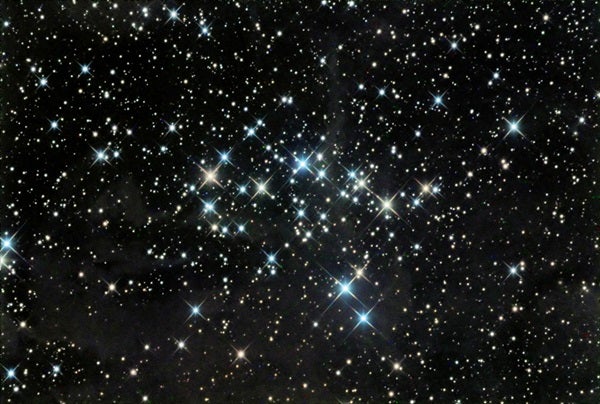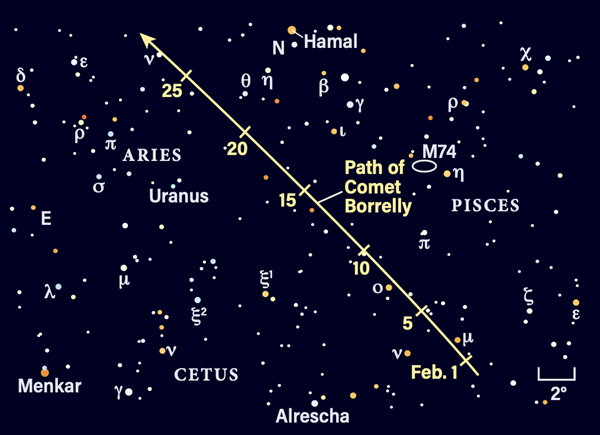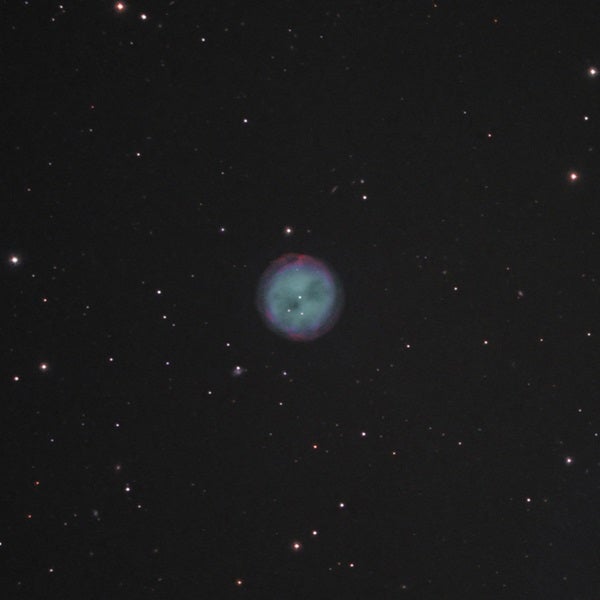Friday, February 18
Still high above the western horizon after dark is Perseus the Hero, located north and slightly west of Taurus the Bull. Tonight, our target is NGC 1342 — an open cluster spanning some 17′ in southern Perseus. It glows at magnitude 6.7 and sits roughly halfway between magnitude 3.4 Rho (ρ) Persei and magnitude 4 Xi (ξ) Persei, also called Menkib. Alternatively, you can use 2nd-magnutude Algol, Perseus’ beta star, as a jumping off point to NGC 1342: Just look about 6° southeast of this luminary to find the cluster.
NGC 1342 is easy to pick up with binoculars or a small telescope, which will resolve it into at least a dozen stars. Larger apertures bring out even more of its 100 or so cluster members. This target is sometimes called the Little Scorpion Cluster, perhaps because it resembles the larger constellation Scorpius the Scorpion. Can you see the similarity?
Sunrise: 6:49 A.M.
Sunset: 5:40 P.M.
Moonrise: 7:53 P.M.
Moonset: 8:09 A.M.
Moon Phase: Waning gibbous (95%)
*Times for sunrise, sunset, moonrise, and moonset are given in local time from 40° N 90° W. The Moon’s illumination is given at 12 P.M. local time from the same location.
Saturday, February 19
On clear, moonless evenings this month, step outside just after sunset to look for the zodiacal light. This soft glow, generated by sunlight hitting the dust left over by countless comets trekking through our region of the solar system, will appear pointing upward from the western horizon. It will be aligned with the ecliptic — the plane of the solar system, along which the planets move.
Look for the zodiacal light’s conical glow extending up through the v-shaped head of Taurus, but keep in that mind you’ll need clear skies free of light pollution to spot it. If you can get to higher altitudes, that will further boost your chances, as you put yourself above more of Earth’s obscuring atmosphere.
Sunrise: 6:47 A.M.
Sunset: 5:41 P.M.
Moonrise: 9:00 P.M.
Moonset: 8:33 A.M.
Moon Phase: Waning gibbous (90%)
Sunday, February 20
Comet 19P/Borrelly, currently observed around magnitude 9.5 and slowly fading, appears to pass close to Uranus in the night sky today. Both are sinking in the west this evening after sunset, situated in the southern portion of Aries.
Although the Ram covers 441 square degrees on the sky, its three brightest stars are all clumped together in the northwestern portion of its real estate. These are Hamal (magnitude 2), Sheratan (magnitude 2.6), and Mesarthim (magnitude 3.9). Tonight, Borrelly sits 6° east-southeast of the last and faintest of the three, while Uranus is another 5° southeast of Borrelly. The planet’s dim magnitude 5.8 glow is just bright enough to pick up with the unaided eye under excellent conditions; binoculars or a telescope will easily show its 3″-wide disk, while binoculars’ wide field of view should also net you the planet and comet together.
Uranus now sits just 0.5° from the 6th-magnitude star 29 Arietis; the planet will move slightly northeast in the coming days, ending the month 43′ from this star.
Sunrise: 6:46 A.M.
Sunset: 5:42 P.M.
Moonrise: 10:08 P.M.
Moonset: 8:58 A.M.
Moon Phase: Waning gibbous (83%)
Monday, February 21
An hour after sunset, the gorgeous open cluster M44 in Cancer already floats more than 35° high. As the darkness deepens, this glittering group of stars may emerge from the background as a 4th-magnitude fuzz.
This easy naked-eye object spans some 95′ and is also known as the Beehive Cluster or Praesepe the Manger. Because it requires no optical aid to spot, it has been known since ancient times and records of it date back to at least 260 B.C. But it doesn’t truly resolve until you point binoculars or a telescope its way, which will show at least several dozen of its 350 stars.
The Beehive is some 580 light-years away and roughly 730 million years old. Researchers think it may have once been associated with the Hyades over in Taurus — perhaps both were birthed in a single giant molecular cloud and moved apart over time.
Sunrise: 6:45 A.M.
Sunset: 5:43 P.M.
Moonrise: 11:18 P.M.
Moonset: 9:24 A.M.
Moon Phase: Waning gibbous (75%)
Tuesday, February 22
Leo the Lion is now rising in the east as the Sun sinks below the horizon. As this great cat climbs the sky, you’ll easily pick out his brightest star, magnitude 1.4 Regulus. Some 150 times brighter than our Sun, this star shines at us from a mere 79 light-years away.
Regulus also marks the base of a well-known asterism called the Sickle of Leo, which looks a bit like a large backwards question mark on the sky. To trace out this figure, move from Regulus about 5° due north to Eta (η) Leonis, the top of the Sickle’s handle. Then, move clockwise to connect Gamma (γ), Zeta (ζ), Mu (μ), and Epsilon (ϵ) Leonis. This asterism also outlines Leo’s head, which faces west on the sky as the Lion appears to sit in profile.
Sunrise: 6:43 A.M.
Sunset: 5:44 P.M.
Moonrise: —
Moonset: 9:53 A.M.
Moon Phase: Waning gibbous (63%)
Wednesday, February 23
Last Quarter Moon occurs at 5:32 P.M. EST. Rising half an hour after midnight, you’ll find our satellite floating at the border of Libra and Scorpius, sitting some 5° northwest of the Scorpion’s claws. A few hours later, the rest of the arachnid’s body has risen, and you can follow a line traveling southeast from the Moon through Delta (δ) and Pi (π) Scorpii to the bright red 1st-magnitude luminary Antares, often depicted as the heart of the Scorpion. Less than 1.5° to Antares’ west is the globular cluster M4, just at the edge of naked-eye visibility at magnitude 5.6 and best viewed with binoculars or a telescope, particularly with the still-lit Moon nearby.
Keep skimming southeast to see Scorpius’ long, curving tail, tipped by bright Shaula and Lesath, which form its stinger. To these stars’ upper left (northeast) are two open clusters of stars: 3rd-magnitude M7, 4.6° east-northeast of the stinger; and 4th-magnutude M6, 5° north-northeast of it. Both are visible with the naked eye under good conditions and can be seen easily with binoculars or any small scope.
Sunrise: 6:42 A.M.
Sunset: 5:45 P.M.
Moonrise: 12:30 A.M.
Moonset: 10:28 A.M.
Moon Phase: Waning gibbous (52%)
Thursday February 24
Following its conjunction with the Sun earlier this month, Saturn is now peeking out from the dawn twilight. Rising roughly half an hour before the Sun, the ringed planet glows at magnitude 0.8 and shares western Capricornus with Mercury, now magnitude 0. By 20 minutes before sunrise, Saturn is just 3° high in the brightening sky, while Mercury is twice that, easier to spot from where it’s sitting to Saturn’s upper right.
Farther west along the ecliptic, you won’t be able to miss Venus and Mars, both in Sagittarius. Venus is the brightest object you’ll see in the sky at magnitude –4.8, just starting to fade from its greatest brilliancy earlier this month. Meanwhile, the Red Planet is fainter than all the rest, shining gently at magnitude 1.3 about 5.5° south of Venus. These two planets rise much earlier — around 4:30 A.M. local time — so you can catch them in a darker sky to also enjoy the rich background of stars and dust they’re currently traveling through.
Sunrise: 6:40 A.M.
Sunset: 5:47 P.M.
Moonrise: 1:44 A.M.
Moonset: 11:11 A.M.
Moon Phase: Waning crescent (41%)
Friday, February 25
The moonless sky after sunset tonight is the perfect place to seek out a nocturnal wonder in Ursa Major: The Owl Nebula. Cataloged as M97, this object is a planetary nebula created as an aging star puffs away its outer atmosphere, lighting it up from within. Such nebulae are short-lived phenomena (cosmically speaking), only lasting a few tens of thousands of years at most. That means we’re lucky to live in a time when we can observe this one, which floats just below the Big Dipper’s Bowl.
Look north after dark and you’ll see the Dipper rising straight upward, standing on its handle. The two stars that line the bottom of its bowl, Phecda and Merak, both shine around magnitude 2. The Owl Nebula sits closer to Merak (which is higher in the sky right now), just 2.3° southeast of this star.
Why is it called the Owl Nebula? The sphere of gently glowing gas appears to have two darker spots within it that look almost like an owl’s trademark large eyes. Thanks to its dim magnitude (10) and broad span (3′), the Owl Nebula has a relatively low surface brightness and will take some work to spot. Avoid magnifying it too much — 100x or less is best — and Astronomy contributing editor Rich Talcott recommends using an OIII filter as well to see the best detail.
Sunrise: 6:39 A.M.
Sunset: 5:48 P.M.
Moonrise: 2:56 A.M.
Moonset: 12:03 P.M.
Moon Phase: Waning crescent (30%)












